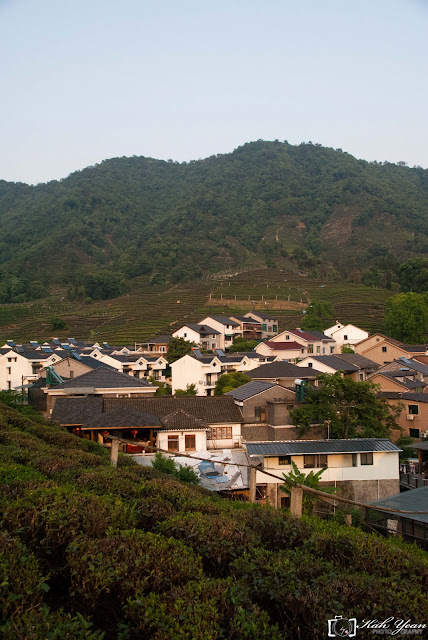Meijiawu Tea Village
Those who loves chinese tea, I'm sure you would have heard about Longjing tea (龙井茶), or it's actually known as dragon well tea. So, Hangzhou's Longjing tea is known as one of the China's best in terms of the quality and grade. So, most tourist groups when you are there, they'll sure bring you to this place, Meijiawu Village, which is basically a Longjing Tea Plantation Village.
The place still looks the same as 10 years ago when I also did visited this place where basically they'll introduce you to their tea which end up you'll probably buy some ...
Yeah, I'm one of them :P
However, as our tour guide who actually stays there in the village itself, and his parents are also into this tea plantation who has a plantation yard as big as i-dont-know-how-to-measure-how-big-it-is, he offered on the last day to have dinner at the village and also we got the opportunity to visit his house ..
Don't have the photos taken at the tour guide's house but got some pictures taken when we went to the back of his house for a stunning scenary and coincidently is sunset ...
Look at all the tea trees :o
The Six Harmonies Pagoda is located on Yuelun Hill overlooking theQiantang River, and south of West Lake (Xi Hu) and is one of the true masterpieces of ancient Chinese architectures. Originally the pagoda was built during the Northern Song Dynasty (386-581) by the ruler of the Wuyue State, a part of which became Zhejiang Province. The name 'Liuhe' comes from the six Buddhist ordinances and it is said that the reason for building this pagoda is to calm the tidal waters of the Qiantang River, and as a navigational aid. However, the pagoda was completely destroyed during a battle in the year 1121.The current pagoda was constructed of wood and brick during the Southern Song Dynasty (420-589), and subsequently, during the Ming (1368-1644) and Qing Dynasties (1644 -1911), additional exterior eaves were added to the pagoda. It is octagonal in shape and some 59.89 meters (196 feet) in height, it also has the appearance of being a thirteen-story structure, though it only has seven interior stories. There is a spiral staircase leading to the top floor and upon each of the seven ceilings are carved and painted figures including animals, flowers, birds and characters. Each story of the pagoda consists of four elements, the exterior walls, a zigzagged corridor, the interior walls and a small chamber. Viewed from outside, the pagoda appears to be layered-bright on the upper surface and dark underneath. That is a harmonious alternation of light and shade.You can also climb up the pagoda but there's a entrance fee charge. Upon ascending the pagoda, you'll have different view of the Qiantang River Bridge. Apparently the bridge is built where there's dual purpose use of it, i.e on top is road track while at the bottom is actually a railway track.
Qinghefang Ancient Street
Extract from china travel guide:
Qinghefang Ancient Street is a section of Hefang Street which is located at the northern foot of Wu Shan Hill in Hangzhou. It is just several hundreds meters away from the beautiful West Lake. With an area of 13 hectares, the street is the only well-preserved part of the ancient city. As a miniature of the city's long history, it is the best place to embody the historical and cultural character of Hangzhou.
Qinghefang has been the most flourished street in the city since the ancient time. During the Southern Song Dynasty, Qinghefang with lots of shops, restaurants and teahouses was the center of politics, culture and commerce in the city. After so many years, it is still a prosperous business area. Many famous century-old shops are located in this ancient street, such as Wangxingji Fan Store, Zhangxiaoquan Scissors, Wanlong Ham Stack, Huqingyutang Pharmacy, Baohetang Pharmacy, Zhuangyuan House, Wangruixing, Yiyuanjindian, Jingyangguan and Sheep Soup Restaurant among others.
Huqingyutang Pharmacy
I tell you ah, this pharmacy right .. is like one of the biggest pharmacy I've ever seen lor ... They even have consultation rooms and wards (if I remember it correctly) .. Is more like a hospital than just a mere pharmacy lor ...
Taiji Teahouse
Oh yeah, we did lepak at this teahouse during at night .. Is basically a teahouse lor .. LOL LOL .. Nothing but tea but the specialty is actually the teapot they use, is those long long one ... Just like that ..
Credit to travelchinaguide.com for this photo simply because I don't know why I didn't take a picture for myself on this .. But basically, is just too many people there that even I wana take a photo without humans in it is just so hardddddd !!! Rawrrr ... See even if I wana take the teahouse also kena blocked by one auntie !
See ! See !! Sure got photobombed !!!
Basically this ancient street is a street that is filled with historic buildings and is a street where you can get some of the local souveniors and handicrafts .. Can take you about an hour to walk from one end to another end but I do think is worth to drop a visit here :D
OK .. Tata for now ... Will try to talk about Mt Putuo, Suzhou and ShaoXing very soon .. !!!



















No comments:
Post a Comment